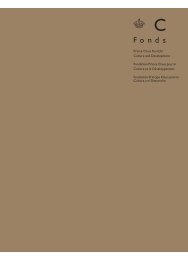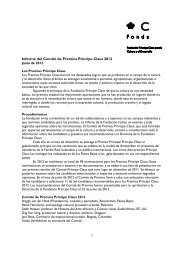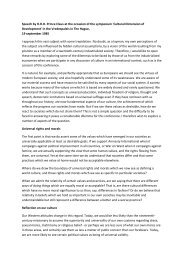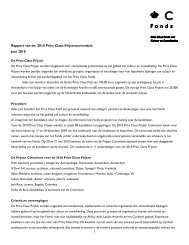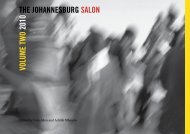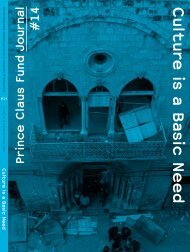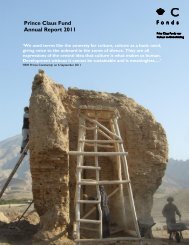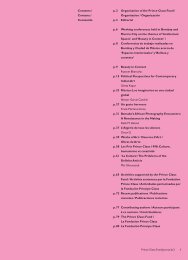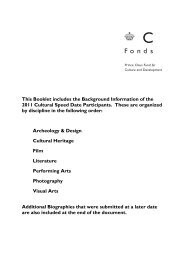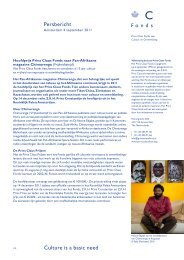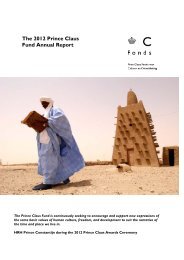3 summer 2011 - Prince Claus Fund
3 summer 2011 - Prince Claus Fund
3 summer 2011 - Prince Claus Fund
- No tags were found...
Create successful ePaper yourself
Turn your PDF publications into a flip-book with our unique Google optimized e-Paper software.
030–053talattekin_alt:turklergaram 29.11.2007 9:22 Uhr Seite 444. Another feature of Crimean Turkish is the preservationof a narrow vowel in a middle syllable: yalıngız “alone,”akılında “in his mind,” çevirilip “turned,” etc.5. Another of the characteristic features of CrimeanTurkic is, as pointed out above, the lack or restriction of labialharmony: kurıp “established” bulunıp, coştırıcı, dortunci “fourth,”kulunçli “ridiculous,” içün, niçün, oldıgı “as it is,” onıng “his/her,”yolımıznı “our way,” etc.6. The partial velarization of the vowels /ö/ and /ü/, andtheir approximation to /o/ and /u/, is also a feature peculiar toCrimean Turkic: boyle “like this,” koz “eye,” buyuk “big,” butun“all,” koster- “to show,” etc.7. Although labial harmony is preserved fully in theSouthern dialect and as far as the second syllable in the Centraldialect, it has completely disappeared in the Northern dialect:Southern tuzluh = Central tuzluk = Northern tuzlık, S çürüklük= C çürüklik = N çüriklik, S xuruluş = C kurulış = N kurılış, Skoylü = C koylü = N koyli “villager,” etc.8. Although the initial /t/ is preserved in the Northerndialect, it changes to /d/ in the Southern dialect: Northern taw= Southern dağ, N tat = S dat “taste,” N tur- = S dur-, N tiş =S diş, N tüş- = S düş-, etc.9. Although the initial /y/ is preserved in the Southerndialect, it changes to /c/ in the Northern: Southern yol =Northern col, S yel = N cel, S yayaw = N cayaw “pedestrian,” Syığ- = N cıy-, S yok = N cok “absent,” etc.10. The written language of Crimean Tatar contains anumber of Oghuz (Turkish) words borrowed from the Southerndialect: adım, dağ, değil, gece, kadın, ocak, oda, ol- , etc.A few sentences in Crimean Tatar: Tang ağarıp yata“Dawn is breaking”’ Saba salkını tenimi çımırdata “The morningwind makes my skin shiver”; Kay etecegimizi bilmeymiz “Wedon’t know what we shall do”; Biz saçuwga azırmız diyler “Theysay they are ready for the harvest”; Oyle tartkan, cardan suvgatüşken “He hit him so hard he fell into the water”; Zalde yengilkulkü koptı “There was some laughter in the salon”; Yüzümsarargan sayın işta:sı da: ziya:de arta eken “As the grapes turnedyellow, his appetite increased.”III. CHAGHATAY GROUPA. The Uzbeks and Their LanguageThe Uzbeks are a Turkic people of mixed Turkic,Mongolian, and Iranian extraction who take their name fromEmir Özbek, one of the emirs of the Golden Horde.The great majority of the Uzbeks live in the Republic ofUzbekistan, whose capital is Tashkent. There are also fairlylarge Uzbek communities in Tajikistan (450,000), Kirghizstan(220,000), Kazakhstan (140,000), and Turkmenistan (125,000).According to the 1989 census, the total number of Uzbeks inthe former Soviet Union amounted to 16,686,244. Adding thenumber of Uzbeks living in Afghanistan (1,390,000), theRepublic of China (15,000), and Turkey brings the number ofUzbek speakers to 19 or 20 million. Modern Uzbek is a continuationof the old Chaghatay written language. Thus, theChaghatay written language may be regarded as “Old Uzbek.”Chaghatay emerged as a classical written language in the eighteenthcentury, with many features borrowed from the Uzbekspoken language. There are several dialects of Uzbek that can44LANGUAGE AND IDENTITYbe classified in four groups: (1) The Khwarezm Kipchakdialects, (2) the Northern Uzbek dialects, (3) the SouthernUzbek dialects, (4) the Khwarezm Oghuz dialects (‹kan-Karabulak, Hive). The Khwarezm-Kipchak dialects of Uzbekbelong to the Kipchak group of Turkic languages, while theKhwarezm-Oghuz dialects belong to Turkmen. According tothis, the true Uzbek dialects are the Northern and Southerndialects in groups 2 and 3. The Southern Uzbek dialects can besubdivided into the following groups: (1) Iranianized dialects:Samarkand, Karshi, Katta-Kurgan, Bukhara, etc.; Tashkent, Ura-Tübe, Cizzah, Leninabad, etc., (2) semi-Iranianized dialects:local dialects; Fergana Uzbek (Fergana, Andican, Kokand,Namangan, etc.). From 1929/30 to 1937, the Uzbek written languagewas based on the Northern Uzbek dialects, which preservedboth phonetic and oral vowel harmony. The Uzbek writtenlanguage underwent radical changes in 1937, when it wasbased (from the point of view of grammar and vocabulary) onthe dialects of the Fergana Valley; in both phonetics and writing,the vowels /›, ö, ü/ disappeared and /a/ was usually labializationin accord with Iranianized Tashkent speech. Until 1930,Uzbek was written using an Arabic alphabet; from 1930 to 1940,it used a Latin alphabet. Since 1940, Uzbek has been written ina Cyrillic-based alphabet.1. One of the main features of the Uzbek written languageis the labialization of the initial /a/: altı > ålti “six,” a:la >ålä “spotted,” a:ra > årä “distance,” ata > åtä “father,” ta:ğ > tåğ“mountain,” yağ- > yåğ-, etc.2. Another characteristic feature of Uzbek is the changeof /›/ to /i/ when unassociated with /q/ and /€/: altı > ålti “six,”altın > åldin, yakşı > yaxşi “well,” yıl > yil “year,” yılan > yilan, etc.3. In Uzbek, the closed /e/ is found only in the initial syllable;in other words, the initial closed /e/ is preserved, but theopen /ä/ is changed to closed /e/: el “folk,” elt- “to send,” ertä“early,” keçä “evening,” är > er “man, husband,” äski > eski, ät> et, ätäk > etäk, käräk > keräk “necessary,” sämri- > semir- “togrow fat,” täri > teri “leather,” etc.4. One of the most important features of Uzbek is thedisappearance of the pronominal /n/ following the third personalsuffix: uy-i-gä “to his house,” årä-si-dän “in between,” åtäsi-gä“to his father,” toğri-si-dä “about,” etc.5. One of the most important features of the Uzbekwritten language is the extensive impairment of vowel harmonyas a result of the disappearance of the vowels /›, ö, ü/: båğli“bound,” toğri “correct, right,” toğrisidä “about,” åräsidä “inbetween,” boldir- “to make happen,” bolim “part,” buzil- “tobecome spoiled,” unli “vowel,” suwsiz “thirsty,” etc.6. Another very important feature of Uzbek is thechange of /€/ and /g/ to /q/ and /k/ at the end of multisyllabicwords: a:çığ > aççiq “bitter,” adığ > ayiq “bear,” sa:rığ > sariq“yellow,” ta:ğlığ > tåğliq “mountaineer,” bilig > bilik “knowledge,”ölüg > olik “dead,” tirig > tirik “alive,” etc.7. The /ö, ü/ sounds in Common Turkic are velarizedwhen unassociated with /k/ and /g/—that is, they are pronouncedas /o, u/: ölüg > olik “dead,” ölüm > olim, tü:n > tun“evening,” tü:ş > tuş “dream,” tüşün- > tuşun- “to understand,”etc.A few sentences in Uzbek: Sizdi korgänimdän xursändmän“I was pleased to see you”; Gäpimgä tuşinäyapsizmi? “DoTonyukuk, who died in 724AD, was the grand vizierand commander-in-chieffor four Gökturk leaders,the best known of whomwas Bilge Khan. His brieflife history, achievements,and regulations for hisadministration were carvedin the TonyukukInscription, found aboutthirty miles outside of UlanBator, Mongolia.<strong>Prince</strong> <strong>Claus</strong> <strong>Fund</strong> Reader #1 · Summer <strong>2011</strong> · 54



